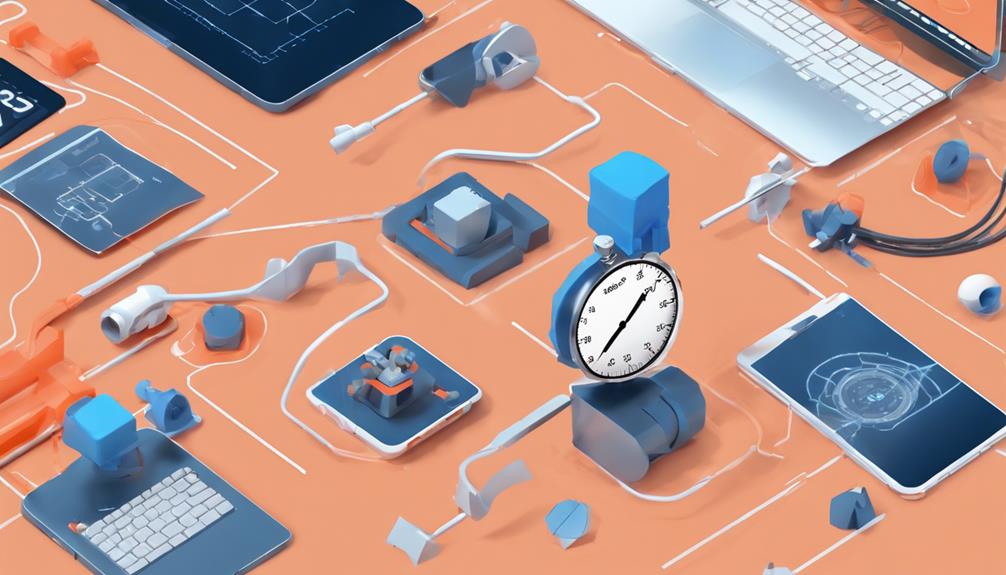To reduce prototype lead times, a multifaceted approach is necessary. Optimize designs for manufacturability by simplifying part geometry and considering material selection and availability. Streamline material sourcing by conducting thorough availability checks and performing supplier lead time analysis. Leverage digital tools for validation, such as simulation software, to predict prototype behavior and identify potential issues early. Implement agile project management strategies to enable rapid iteration and continuous feedback. Additionally, utilize rapid prototyping techniques, efficient communication strategies, and simulation-driven design to further accelerate timelines. By integrating these essential tips, you can access faster prototyping and high-quality product delivery, and discover even more strategies to enhance your prototyping process.
Key Takeaways
- Simplify part geometry and collaborate with manufacturers to address design constraints and reduce lead times.
- Leverage digital tools like simulation software for virtual testing to identify potential issues early in the design process.
- Implement agile project management strategies to foster collaboration, enable quicker decision-making, and reduce lead times for prototyping projects.
- Optimize material sourcing by conducting thorough material availability checks, verifying lead times, and maintaining good relationships with suppliers.
- Embrace simulation-driven design to reduce the number of iterations required for a viable product, and predict design behavior using simulation software.
Optimize Design for Manufacturability
Moreover, optimizing design for manufacturability is an essential step in reducing prototype lead times, as it enables the creation of parts that can be efficiently and effectively produced.
By simplifying part geometry, designers can reduce complexity and facilitate faster and more cost-effective manufacturing processes. This, in turn, reduces the need for specialized tooling, expediting the manufacturing process.
Additionally, material selection and availability should be considered during the design phase to minimize lead times. To achieve this, designers should collaborate with manufacturers early on to address any design constraints that may impact production speed. By doing so, they can identify and eliminate potential production bottlenecks, reducing the overall lead time.
Streamline Material Sourcing Process

When streamlining the material sourcing process, it is crucial to conduct thorough material availability checks to verify that required materials are accessible within the desired timeframe.
Additionally, performing supplier lead time analysis helps identify reliable suppliers with shorter lead times, further expediting the prototyping process.
Material Availability Checks
Conducting regular material availability checks is essential to streamline the sourcing process and prevent delays in prototype development. This proactive approach enables teams to verify lead times for materials, ensuring timely procurement for prototypes.
By maintaining good relationships with suppliers, teams can expedite material delivery, reducing the risk of delays. Leveraging online platforms or software to track material availability allows for effective planning and minimizes the likelihood of last-minute shortages.
To further mitigate risks, teams should plan ahead and order materials in advance, avoiding the need for rushed procurements. By integrating material availability checks into the sourcing process, teams can greatly reduce lead times, paving the way for faster prototype development.
Supplier Lead Time Analysis
By scrutinizing supplier lead times, teams can pinpoint inefficiencies in the material sourcing process, enabling targeted improvements to reduce delays and accelerate prototype development.
A thorough supplier lead time analysis is essential to streamline the material sourcing process, allowing teams to reduce lead times and optimize the procurement process.
By working closely with suppliers, teams can identify bottlenecks and delays, and implement strategies to minimize lead times, such as vendor consolidation and bulk ordering.
Continuous monitoring and evaluation of supplier lead times enable informed decisions, ensuring that the procurement process is optimized to reduce lead times.
By leveraging data on supplier lead times, teams can make strategic decisions to accelerate prototype development, ultimately reducing lead times and improving overall efficiency.
Leverage Digital Tools for Validation

Digital tools, such as simulation software, have revolutionized the validation process. Designers can now test and refine their designs in a virtual environment before investing in physical prototypes. This paradigm shift has greatly reduced the time spent in validation stages, ultimately contributing to decreasing lead times toward mass production.
By leveraging digital tools, designers can identify potential issues early in the design process, reducing the need for multiple iterations and subsequent rework. Virtual testing also allows for real-time performance monitoring and adjustments, enabling designers to optimize their designs for peak performance.
In addition, simulation tools can predict how prototypes will behave under different conditions, aiding in design optimization. By eliminating the need for physical testing, virtual validation can significantly expedite the prototyping process, resulting in reduced lead times and accelerated time-to-market.
Implement Agile Project Management

In order to effectively implement Agile project management, breaking down silos and prioritizing iterative development are crucial. Embracing flexibility in all aspects of the prototyping process is key to success.
This approach allows teams to respond quickly to changing requirements and deliver value rapidly. By adopting these principles, teams can streamline their workflow, reduce lead times, and create high-quality prototypes that meet stakeholder expectations.
Break Down Silos Now
Implementing Agile project management can be an essential step in breaking down silos, as it fosters a collaborative environment that allows teams to work together seamlessly. By adopting Agile methodologies, organizations can reduce lead times for prototyping projects and promote a culture of transparency and adaptability.
Here are three key benefits of breaking down silos with Agile project management:
- Faster Decision-Making: Cross-functional teams in Agile enable quicker decision-making and problem-solving, reducing the time spent on prototyping.
- Improved Collaboration: Agile project management breaks down silos, allowing teams to work together more effectively and reduce lead times.
- Enhanced Transparency: Agile methodologies like Scrum and Kanban promote transparency, enabling teams to identify and address issues promptly, reducing lead times and improving overall project efficiency.
Prioritize Iterative Development
By embracing iterative development, organizations can greatly reduce prototype lead times, as Agile project management enables rapid iteration, continuous feedback, and adaptability to change. This approach allows teams to identify and address issues early on, saving time and resources in the long run.
Agile methodologies, such as Scrum or Kanban, facilitate quick iterations and feedback, enabling teams to adapt to changes and deliver prototypes faster. By breaking down the project into manageable tasks, Agile project management increases efficiency and accelerates prototyping timelines.
Prioritizing iterative development in Agile project management leads to higher-quality prototypes and faster time-to-market. This approach enables teams to respond quickly to changing requirements, reducing the risk of project delays and cost overruns.
Embrace Flexibility Always
Agility is the cornerstone of responsive prototype development, and embracing flexibility always through Agile project management empowers teams to navigate the complexities of iterative development with ease. By adopting Agile methodologies, teams can respond rapidly to changing requirements, reducing lead times and accelerating time-to-market. This flexibility enables teams to prioritize iterative development, focusing on delivering working prototypes in short cycles.
Here are three key benefits of embracing flexibility with Agile project management:
- Rapid Iteration: Agile's iterative approach allows for rapid prototyping and testing, reducing lead times and enabling teams to respond quickly to customer feedback.
- Cost-Effective: By reducing lead times, Agile project management helps reduce costs associated with prolonged development cycles, enabling teams to reduce costs and optimize resource allocation.
- Enhanced Collaboration: Agile promotes collaboration between teams and stakeholders, ensuring that everyone is aligned and working towards a common goal, resulting in efficient printing and production processes.
Rapid Prototyping Techniques for PCBs

Leveraging additive manufacturing processes, PCB rapid prototyping techniques enable the rapid fabrication of printed circuit boards, drastically reducing lead times and accelerating product development cycles. By utilizing 3D printing and additive manufacturing, PCB manufacturers can bypass traditional fabrication methods, producing prototypes in a fraction of the time.
| Prototyping Technique | Lead Time | Advantages |
|---|---|---|
| Traditional Fabrication | 4-6 weeks | High-volume production |
| 3D Printing | 24-48 hours | Rapid iteration, low-volume production |
| Additive Manufacturing | 1-3 days | Complex geometries, reduced material waste |
| Rapid PCB Prototyping | 1-5 days | Quick turnaround, iterative design |
| Hybrid Manufacturing | 2-5 days | Combines traditional and additive techniques |
These rapid prototyping techniques allow for quick iteration and testing of PCB designs, resulting in faster product development cycles. By embracing advanced technologies, PCB manufacturers can expedite the production of prototypes and meet tight project deadlines.
Efficient Communication Strategies

Effective communication is the linchpin of successful prototype development, as it enables seamless collaboration and fosters an environment of transparency and accountability. To achieve this, it is crucial to implement efficient communication strategies that facilitate information flow and collaboration among design, engineering, and production teams.
Here are three key strategies to optimize communication:
- Establish clear communication channels:
Define and maintain open communication channels to guarantee that all stakeholders are informed and aligned throughout the prototype development process.
- Utilize project management tools:
Leverage tools like Trello or Asana to track progress, assign tasks, and monitor timelines, ensuring that all team members are on the same page.
- Hold regular cross-functional meetings:
Schedule regular meetings to discuss project timelines, address challenges, and make collaborative decisions, ensuring that all stakeholders are aligned and working towards a common goal.
Reduce Iterations With Simulation

By embracing simulation-driven design, prototype developers can greatly reduce the number of iterations required to achieve a viable product, thereby streamlining the overall development process. This approach leverages simulation software to predict how a design will behave before physical prototyping, reducing the need for multiple iterations.
By analyzing stress, heat distribution, and fluid flow, simulations can optimize designs for faster prototyping. Simulation tools like ANSYS and SolidWorks help identify potential issues early in the design process, saving time and resources. Virtual testing through simulations can speed up the iteration process and lead to more accurate prototypes.
Integrating simulation into the prototyping workflow can considerably reduce lead times by minimizing design revisions. By reducing design iterations, developers can accelerate their product development timeline, getting their products to market faster.
Frequently Asked Questions
Which Prototype Helps Reduce Development Time?
'Cut to the chase' and get straight to the point – the prototype that helps reduce development time is the 3D printed prototype.
This cutting-edge technology enables rapid prototyping, allowing for swift iteration and refinement of designs.
How Can I Make My Prototype Better?
To create a superior prototype, focus on refining your design for best performance and manufacturability. Conduct thorough testing and analysis to identify areas for improvement.
Implement feedback from stakeholders and end-users to inform iterative design refinements. Additionally, consider incorporating innovative materials and technologies to enhance functionality and user experience.
What Are the Factors to Be Considered When Planning to To Use Prototypes?
When planning to utilize prototypes, several vital factors must be considered.
The complexity of the design, material selection, and prototyping method are essential considerations for efficient planning.
Additionally, the impact of lead time on production costs, development time, and time-to-market must be evaluated.
Moreover, preparation time for tooling and setup, as well as production time based on technology and part complexity, must be assessed to optimize lead times for prototype development.
What Considerations Need to Be Made While Moving From Prototype to Production?
As the prototype takes its final bow, the curtains open to the grand stage of mass production. However, the spotlight shines brightest on scalability, as production volume requirements take center stage.
It is imperative to evaluate cost-effective manufacturing processes, optimize design for manufacturability, and collaborate with suppliers to guarantee timely sourcing of materials. By doing so, companies can harmoniously orchestrate the shift from prototype to production, ensuring a seamless and efficient performance.


